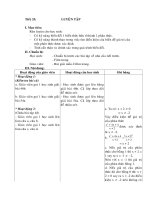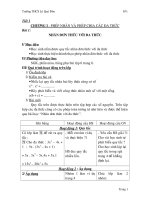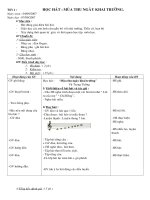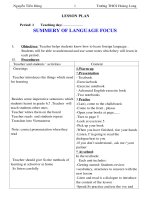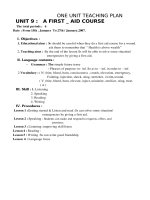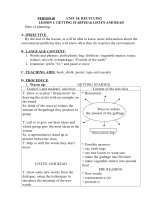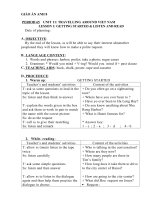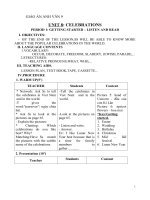GIÁO AN TIẾNG ANH 8 (HỌC KỲ I)
Bạn đang xem bản rút gọn của tài liệu. Xem và tải ngay bản đầy đủ của tài liệu tại đây (425.92 KB, 97 trang )
Period: 1 Date of planning:
Week: 1 Date of teaching:
RIVISION / CHECKING
I. Objectives:
- Help students review the old knowledge
- Focus on writing skill
II. Language content:
The exercises
III. Teaching aids:
VI. Procedures:
1. Warm - up:
Teacher’s activities Students’ activities Content
- ask students some questions - answer - What do you do prepare for
the first new school year?
- How do you feel when you
come back to school?
2. Practice:
- introduce the content of
the exercises
- write the exercises on the
board
- take note
- copy in the book
Choose the beat answer:
1. What … we eat? - How about some
snack?
a. are b. shall c. does
2. What ….. would you like for lunch?
- Pork
a. fruit b. vegetable c. meat
3. …… have some beef and fish for
dinner? – OK
a. Let’s b. Let c. lets
4. I don’t like chicken - ……. do I
a. Either b. Neither c. so
5. You must drink …. Water everyday.
– Yes, doctor.
a. A little b. much c. many
6. What is your favorite ….? – Cycling
a. sport b. pastime c. both a, b
are correct
7. Does Nam run quickly? – No. He
runs very …..
a. quickly b. well c. slowly
8. I swim very slowly – so ….
a. am I b. I do c. do I
9. Is this a safe road? – Yes, you can
ride……. On it.
a safe b. safely c. safety
10. Nam ….a lot last week. Did he?
A. was read b. reads c. read
11. I …. Anew blouse yesterday
Lesson plan 8 /Created by TRẦN QUỐC TUẤN / Trường THCS An Trạch / Đông Hải – Bạc Liêu
- have students work
individually do the
exercises by choosing the
best answer
- have students circle the
best answer on the board
- check and feed back
- work individually
do the exercises by
choosing the best
answer
- circle the best
answer on the board
a. buy b. bought c. buying
12. She invited…… to come to her
birthday party. – Great
a. I b. my c. me
13. Are you busy …… Saturday? – I’m
not sure – Why?
a. at b. in c. on
14. What do you think about our TV
programs? – Well, there are not
many good programs …… teenagers.
a. for b. of c. in
15. Do you think life here is more ….
now? – Certainly it is
a. comforting b. comfortable
c. comforts
Answer keys:
1b, 2c, 3a, 4b, 5b, 6c, 7c, 8c, 9b,
10c, 11b, 12c, 13c, 14a, 15b.
3. Consolidation:
- have students ask and
answer the questions in the
exercises in pairs
- ask and answer the
questions in the exercises in
pairs
4. Home work:
- Practice the exercises at home
- Prepare Unit 1: “Getting started, Listen and read”
eriod: 2 Date of planning:
Week: 1 Date of teaching:
UNIT 1: MY FRIENDS
Lesson 1: Getting stared, Listen and read
I. Objectives:
- Competencies: Introduce the topic of the lesson
- review the favorite activities of students
- Practice describing about friends
- Develop listening and speaking skills
II. Language content:
Vocabulary: seem (v)
Grammar: - What + do / does + S + look like?
Lesson plan 8 /Created by TRẦN QUỐC TUẤN / Trường THCS An Trạch / Đông Hải – Bạc Liêu
- What + N!
- To be (not) Adj + enough + to do
III. Teaching aids:
Pictures, cassette player
VI. Procedures:
1. Warm -up
Teacher’s activities Students’ activities Content
- organize students to ask and
answer about summer
holidays in pairs
- have students look at the
picture part Getting stared and
introduce.
Being with friends is one of the
most popular leisure activities
we have 4 pictures describing
the various activities done by
different groups of friends.
Now you work in groups of
three or four. Each group
describe a pictures
- work in pairs
- look at the picture
part Getting stared and
introduce.
- work in groups
- What did you do during the
summer vacation?
- What do you remember most?
- Did you have any new friends?
- How many people are there in
each picture?
- Were are they?
- What are they doing?
- Are they all the boys?
- What time of the day do you think
it is?
- Do you like to do it?
Picture a: They are playing soccer
They are in the field. They are all the
boys.
Picture b: There are three people.
They are reading books. They are in
the library. They are all the girl. I
think it is Sunday
Picture c: There are two people.
They are playing chess. They are at
home .
Picture d: There are four people.
They are playing volleyball. They are
in the yard.
2. Presentation:
- elicit some questions
- shows pictures (Hoa, Lan,
photo of Hoa and Nien) and
introduces the dialogue:
“Lan and Hoa are talking
about Hoa’s photograph”
- play the tape
- introduce newword and
- answer
- listen
- liaten to the tape
- copy in the book
- Do you remember Hoa?
- Where does she come from?
- Who does she live with now?
- Which grade is she in?
(As you know. Hoa comes from Hue.
She is talikng to Lan about one of her
friends in Hue)
Newword: seem (v)
Lesson plan 8 /Created by TRẦN QUỐC TUẤN / Trường THCS An Trạch / Đông Hải – Bạc Liêu
structure
Structures:
- What + do / does + S + look like?
- What + N!
- To be (not) Adj + enough + to do
EX:
What does she look like?
What a lovely house!
She is not good enough to do this
math exercises.
3. Practice:
- play the tape again
- have students practice the
dialogue in pairs
- call some typical pairs to
practice in front of class
-have students answer the
questions
- call students to read the answer
loudly
- listen to the tape
- practice the dialogue in pairs
- practice the dialogue in front
of class
- answer the questions
- read the answer loudly
Answer:
a. Nien lives in Hue.
b. No, she doesn’t
c. She wasn’t old enough to
be in my class.
d. Nien is going to visit Hoa
at Christmas.
4. Consolidation:
- remind the content of the
dialogue, structure with look
like and enough
- take note
5. Home work:
- Practice the dialogue
- Make sentences foe each structure.
- Prepare “Speak”
Period: 3 Date of planning:
Week: 1 Date of teaching:
UNIT1: MY FRIENDS
Lesson 2: Speak
I. Objectives:
- Help students know the way to describe the build of someone by getting aquatinted
with adjectives such as: tall, short, straight, curly …
- Focus on speaking skill
II. Language content:
Vocabulary: blond (a), curly (a), fair (a), bald (a), slim (a), straight (a)
Grammar: - What + do / does + S + look like?
Lesson plan 8 /Created by TRẦN QUỐC TUẤN / Trường THCS An Trạch / Đông Hải – Bạc Liêu
- S + be + adj / S + has / have
III. Teaching aids:
Pictures
VI. Procedures:
1. Warm -up
teacher’s activities students’ activities Content
- have one pair role play the
dialogue
- have students make two
sentences base on the
structure to describe people
- role play the dialogue
- make two sentences base
on the structure to describe
people
- What + do / does + S + look
like?
Ex:
- What does Lan look like?
- What do Ba and Nga look like?
2. Pre - speaking:
- organize the game networks
about build and hair
- elicit
In daily life, we always have
to communicate with other
people thus, it is important to
know the adjectives and
structures describing a
person’s appearances in this
we will deal this matter
- have students look at the
pictures part 2 page 11
- explain adjectives to
describe build
- enlarge some adjectives to
describe build
- have students practice the
dialogue part1 page 11
- explain and review the
structure to ask and describe
the build
- play game
- listen to the teacher
- look at the pictures
part 2 page 11
- copy in the book
- repeat adjectives
- practice the dialogue
part1 page 11
- take note
tall short fat
slim thin
long short straight
curly bald
black blond brown
Vocabulary: blond (a), curly (a), fair
(a), bald (a), slim (a), straight (a)
Eye: blue, green, brown, sharp
Forehead: high, low
Face: round, long, oval
Structures:
- What + do / does + S + look like?
- S + be + adj / S + has / have
Ex:
- What does she look like?
- She is think and short.
- She has long and blond hair
3. While - speaking:
- have students look at the
pictures a,b,c,d,e,f and make
similar dialogue by using the
adjectives and dialogue you
have practiced to describe the
people in the pictures: Van,
- work in pairs
Lesson plan 8 /Created by TRẦN QUỐC TUẤN / Trường THCS An Trạch / Đông Hải – Bạc Liêu
build
hair
hair
Mr. Lai, Miss Lien, An, Mr.
Khoi, and Mary.
- give the model dialogue
- call some pairs to practice
the dialogue in front of class.
- give feed back
- make reference
- practice the dialogue in front
of class.
A: What does van look like?
B: He is tall and think. He has
short black hair.
4. Post - speaking:
- remind the structures to ask
and answer about the build of
some one
- listen and remember
5. Homework:
- Describe a person that you love (father, mother, brother, sister…)
- Prepare Listen
- Prepare “Speak”
Period: 4 Date of planning:
Week: 2 Date of teaching:
UNIT 1: MY FRIENDS
Lesson 3: Listen
I. Objectives:
- Review structures when someone is introduced with others and the way to response
- focus on listening skill
II. Language content:
Structures:
- Nice to / pleased to / good to / glad to / meet (see) you
- How do you do?
- It’s pleasure to meet you
- I’d like to meet …
III. Teaching aids:
Cassette player, extra board, paper A4
VI. Procedures:
1. Warm -up
teacher’s activities students’ activities Content
- organize students to ask and
answer
- give students a paper
consisting of questions
prepared
- answer the question in
pairs
- How tall are you?
- How would you describe your
build?
- What color are you eyes?
- What kind of hair do you have?
- What color is it?
- Do you think you have any special
features?
- Can you think of a famous woman
you describe as beautiful, and a man
you describe as husband?
Lesson plan 8 /Created by TRẦN QUỐC TUẤN / Trường THCS An Trạch / Đông Hải – Bạc Liêu
2. Pre - listening:
- elicit
- explain structures to
introduce and response
- have students read the
dialogues and guess phrases.
That they need to fill the
conversations
- listen and answer
- listen and copy in the
book
- read the dialogues and
guess phrases. That
they need to fill the
conversations
- What do you say if you want to
meet someone?
(I’d like to meet …)
- What will you say when you are
introduced to someone?
(How do you do, nice to meet (see)
you)
- What will you say when you
introduce someone?
(This is … )
Structures:
- Nice to / pleased to / good to / glad
to / meet (see) you
- How do you do?
- It’s pleasure to meet you
- I’d like to meet …
3. While - listening:
- introduce
We are going to listen 4
dialogues different
situation. Each dialogue
has some missing
information you listen to
the tape and complete
the dialogue
- play the tape three
times
- have students compare
the answers with a
friend
- give the correct
answer and listen the
tape again
- listen to the
tape
- compare the
answers with a
friend
- listen and
check the
answer
a. (1). I’d like you to meet
(2).Nice to meet you
b. (3). I’d like you to meet
(4). It’s a pleasure to meet you.
c. (5). Come and meet
d. (6). How do you do?
Tape transcript:
a. Hoa: hello, Nam
Nam: Morning, Hoa
Hoa: Nam, I’d like you to meet my cousin,
Thu
Nam: Nice to meet you, Thu
Thu: Nice to meet you, Nam
b. Khai: Miss Lien, I’d like you to meet my
mother
Miss Lien: It’s a pleasure to meet you, Mrs.
Vi
Mrs. Vi: The pleasure is all mine, Miss Lien.
Miss Lien: Oh, there is the principal. Please
excuse me, Mrs. Vi, but I must talk to him.
Mrs. Vi: Certainly
c. Ba: Bao, come and meet my grandmother.
Bao: Hello, ma’am.
Grandmother: Hello, young man.
Lesson plan 8 /Created by TRẦN QUỐC TUẤN / Trường THCS An Trạch / Đông Hải – Bạc Liêu
Ba: Bao is my classmate, grandmother.
Grandmother: What was that?
Ba: Classmate! Bao is my classmate.
Grandmother: I see.
d. Mr. Lam: Isn’t that Lan’s father, my dear?
Mrs. Linh: I’m not sure. Go and ask him.
Mr. Lam: Excuse me. Are you Mr. Thanh?
Mr. Thanh: Yes, I am
Mr. Lam: I’m, Nga’s father.
Mr. Thanh: How do you do?
4. Post - listening:
- have students build a new
dialogue base on the dialogue
fusty finished
- give feed back
- build a new dialogue
5. Home work:
- learn the dialogue by heart
- prepare Read
Period: 5 Date of planning:
Week: 2 Date of teaching:
UNIT 1: MY FRIENDS
Lesson 4: Read
I. Objectives:
Help students know the way to describe character of someone through characteristic
adjectives.
II. Language content:
Vocabulary: character (n), social (a), generous (a), hard – working (a), reserved (a), out
going (a), sense of humor (n) = humorous (a), kind (a)
III. Teaching aids:
Picture
VI. Procedures:
1. Warm -up
teacher’s activities students’ activities Content
- organize students to play
game find someone whom
character of members in
class.
- have students make ‘Yes
/No questions ( Who usually
helps other people)
- have students if they answer
(Yes) write name in “name
column” and who can write in
“name column” fully first in
- make ‘Yes / No
questions
FIND SOMEONE WHO NAME
Usually helps other
people
Doesn’t speak a lot in
public
Always goes to the
library
Sometimes tells funny
stories
Smiles a lot
Lesson plan 8 /Created by TRẦN QUỐC TUẤN / Trường THCS An Trạch / Đông Hải – Bạc Liêu
winner
2. Pre - reading:
- elicit
This game tells you the
characters of people in the
class. Which adjectives do you
use to describe the one who
always helps other people?
(Kind/ helpful) or the one who
always tells jobs? (humorous)
- provide some new words
- introduce: You are going to
read the text about Ba’s
friends. Each one has his own
characters you can scan the
reading and tall me how many
people the text describe.
- listen to the teacher
- copy in the book
New words:
- character (n): cá tính
- social (a): xã hội
- generous (a):rộng lượng
- hard – working (a):
- reserved (a): dành riêng
- out going (a):
- sense of humor (n) =
humorous (a): khôi hài
- kind (a):
3. While - reading:
- have students read the new
words
- call two students to read the
new words
- read the text three times
- call students read the text in
front of class
- have students read the text
and answer the questions in
part 1
- have students compare the
answers with a friend.
- call some students to read
the answers loudly
- give correct answer.
- continue to introduce:
We understand little about
- read the new words after
teacher
- read the new words
- listen to the teacher
- read the text in front of class
- read the text and answer the
questions in part 1
- compare the answers with a
friend.
- read the answers loudly
- do exercise part 2
Part 1:
a. Ba talks about three of his
friends
b. Bao’s volunteer work
does not affect his school
work.
c. Khai and Song don’t talk
much in public.
d. Bao’s friends sometimes
get tired of his jokes.
Lesson plan 8 /Created by TRẦN QUỐC TUẤN / Trường THCS An Trạch / Đơng Hải – Bạc Liêu
characters of persons in the
text to know more imformation
about these persons you read
the text again and do
exercises part 2 answer the
questions
- have students compare the
answers
- call some students to
compare the answers
- give feed back
- compare the answers
- compare the answers
- copy in the book
Part 2:
a. Ba feels lucky having a lot
of friends
b. Bao is the most social
c. Khai likes reading.
d. A bad thing about Ba’s
jokes is that sometimes
his jokes annoy
laøm
traùi y
ù his
friends
e. He spends his free time
doing volunteer work at a
local orphanage
4. Post – reading:
- call some students to read
the text
- have students work in the
groups discuss the question f
- read the text
- work in groups
Do you and your close friends
have the same or different
character?
5. Home work:
Period: 6 Date of planning:
Week: 2 Date of teaching:
UNIT 1: MY FRIENDS
Lesson 5: Write
I. Objectives:
By the end of the lesson, students will be able to write a paragraph about their close
friends.
II. Language content:
III. Teaching aids:
Text book, pictures page 17
VI. Procedures:
1. Warm -up
teacher’s activities students’ activities Content
- ask students to look at the
pictures on page 17 quickly.
Then let them keep their
books close.
- divide class into four groups
- give students two questions
the group which answers
correctly the fastest wins the
game
- look at the pictures on page
17 quickly
- work in groups 1. How many people are
there in the picture?
( Four)
2. What is each person
Lesson plan 8 /Created by TRẦN QUỐC TUẤN / Trường THCS An Trạch / Đông Hải – Bạc Liêu
wearing?
The woman is wearing a
red shirt and green skirt.
The man who is standing
beside the car is wearing
brown trousers and yellow
shirt.
The man who is standing
on the pavement is
wearing a pink shirt and
blue trousers.
The boy is wearing blue
shorts and a white shirt.
2. Pre - writing:
- ask students to read the
information about Tam then
answer some questions
- read the information about
Tam then answer some
questions
Questions:
a. What is his mane?
(Le Van Tam)
b. How old is he?
(14)
c. What does he look like?
(He is tall and thin. He has
short black hair)
d. What is he like?
(He is social, humorous
and helpful)
e. Where does he live?
(He lives at 26 Tran Phu
Street, Hanoi)
f. Whom does he live with?
(He lives with her mother,
father and an elder
brother)
g. Who is he friend?
(Ba and Bao)
3. While - writing:
- let students write a
paragraph about Tam, using
the information they have just
got.
- ask students to compare with
the paragraph in their book on
page 15.
- ask students to write some
information about one of their
friends, and then write a
paragraph about him or her.
- work individually.
- compare with the paragraph
in their book on page 15.
- work individually.
Lesson plan 8 /Created by TRẦN QUỐC TUẤN / Trường THCS An Trạch / Đông Hải – Bạc Liêu
- get students to share with
their partners and correct if
possible
- pairs work
Sample:
His / her name is … and
homework / she is … years
old. He / she ….. lives at ……. in
…….. with his grandmother, his
parents and his younger sister,
Mai. He / she is tall and
slender. He / she has short
black hair. He / she rather shy
but friendly and helpful. He /
she has a lot of friend but his /
her close friends are …. And
…..
4. Post - writing:
- ask students to write a
similar paragraph about
himself / herself
- move around the class and
help students, then ask some
students to speak in front of
the class about himself /
herself
- work individually.
- speak in front of the class
about himself / herself
5. Home work:
- Ask students to write anther paragraph about one of their family members.
- prepare Language focus
Period: 7 Date of planning:
Week: 3 Date of teaching:
UNIT 1: MY FRIEND
Lesson 6: Language focus
I. Objectives:
By the end of the lesson, students will be able to use simple present tense to talk about general
truths and writ some sentences using the structure “(not) + adjectives enough + to-infinitive”
II. Teaching aids: Extra board, pictures
III. Procedures:
1. Warm -up
teacher’s activities students’ activities Content
- have students work in pairs,
remind the form and use of the
simple present tense and simple
past tense
- remind
Simple present tense:
To be: is / are / am
(+) S (soá ít) + is
S (soá nhieàu) + are
S + am
(-) S + is / are / am + not
(?) Is / Am / Are + S?
Ordinary verb:
(+) S (soá ít) + V(s/es)
Lesson plan 8 /Created by TRẦN QUỐC TUẤN / Trường THCS An Trạch / Đông Hải – Bạc Liêu
S (soá nhieàu) + Vo
(-) S + do / does + not + Vo
(?) Do / Does + S + Vo?
Yes + S + do / does
No + do / does +not
Use: it expresses an action that happens in
present
Simple past tense:
To be: was / were
(+) S (soá ít) + was
S (soá nhieàu) + were
(-) S + was + not
S + were + not
(?) Was / Were + S + …?
Ordinary verb:
(+) S + V
2
/ V-ed
(-) S + didn’t + Vo
(?) Did + S + Vo?
Yes, + S+ did / No, + S+ didn’t
Use: It expresses an action that happens
in the past.
2. Practice:
- elicit
We have two passages and some verbs that
are not in the right form. You read the
passages and put the verbs in the present
simple and past simple tense
- call some students to read the completed
passages
work in
pairs
- read the
completed
passages
Activity 1:
a. 1. lives, 2 sent, 3was, 4 is,
b. 1. are, 2.came, 3.showed, 4
introduced
-explain
Apart from expressing the repeated /
habitual actions which happen daily, the
present simple tense can also be used to
describe actions which are always known
as truth. You will understand more when
you finish exercise 2. Complete the
dialogue. Use the correct form of the verbs
in the box. You can use some verbs more
than once
- have students read the completed the
dialogue
- explain more about the simple present
tense
- listen to the
teacher
- read the
completed the
dialogue
- take note
Activity 2:
1. sets
2. goes
3. moves
4. is
5. is
6. is
the verbs in exercise 2 are all used in
the simple present tense and it expresses
the truth
ex: Water boils at 100 degrees Celsius
- Students don’t go to school on Sunday
- have students look at the pcturepart3
page 17.
- ask students to answer the questions in
pictures
Give some words:
- heavy set : chaéc nòch
- hold one’s head : oâm ñaàu
- look at the
picture
- work pairs
- copy in the
book
Activity 3:
a. There are 4 people in the picture.
b. There is a tall, heavy set man;
there is a tall, thin woman with
short hair, there is a boy sitting on
the aground, holding his head, and
there is a short man standing across
Lesson plan 8 /Created by TRẦN QUỐC TUẤN / Trường THCS An Trạch / Đông Hải – Bạc Liêu
- shoulder bag: túi khoác vai
- short
the street.
c. The man standing next to the taxi is
wearing a yellow shirt and black
trousers; the woman is carrying a
shoulder bag, and is wearing a
green skirt and red blouse. The boy
sitting on the ground and holding
his head is wearing blue shorts and
a white shirt, and the man across
the street is wearing blue trousers
and a pink shirt.
- review the structure.
- have student do exercise
- take note
- pairs work
Activity 4:
(not) + adj + enough + to-infinitive
Đủ/ không đủ … để làm gì
Ex:
- Can you hang this picture over there?
- No, I am not tall enough to hang hthe
picture over there.
b. Hoa: Is ba going to drive his father
car?
Lan: Don’t be silly. Ba is not
old enough to drive a car.
c. Hoa: Do you need any help?
Lan: No, thanks. I am strong
enough to lift this box.
d. Hoa: Why don’t you join pour
English Speaking Club?
Lan: I don’t think my English is
good enough to be a member
3. Home work:
Prepare Unit 2: getting started, listen and read
Period: 8 Date of planning:
Week: 3 Date of teaching:
UNIT 2: MAKING ARRANGMENTS
Lesson 1: getting started, listen and read
I. Objectives:
By the end of the lesson, students will be able to use the telephone to make and
confirm arrangements.
II. Language content:
Vocabulary: mobile (n), downstairs (n)
Structure: - Can I speak to …?
- Would you like …?
- Let’s …
III. Teaching aids:
Pictures, cassette player
VI. Procedures:
Lesson plan 8 /Created by TRẦN QUỐC TUẤN / Trường THCS An Trạch / Đơng Hải – Bạc Liêu
1. Warm -up
teacher’s activities students’ activities Content
- ask students to match each
object (pictures on page 18
with its name
- match each object (pictures
on page 18 with its name
a. An answering machine.
b. A mobile phone
c. A fax machine
d. A telephone directory
e. A public telephone
f. An address book
2. Presentation:
- introduce
As we know, telephone has
become more and more
popular in our social
communication. Thus, it is
necessary foe English learners
to have good skill of using and
understanding the language
use in the telephone. In grade
7, we learned how to read
telephone number and some
other related structures. In
this period, we will further
study this topic.
- play the tape
- review the ways to read
telephone numbers, the
structure to talk with some
one on the phone and the
structure about invitation or
suggestion.
- explain some more
structures in the dialogue
- listen to the teacher
- take note
The way to read telephone
numbers:
Ex: 3 847 329: three, eight
four seven, three two nine
Structure:
- Can I speak to …?
- Would you like …?
- Let’s …
- She is downstairs ><
upstairs
- It’s a bit far from my house
(noù caùch nhaø toâi khaù xa)
3. Practice:
- play the tape
- have students role play
- play the again and have
students do exercise 2 in the
book page 19.
- have students exchange and
compare the answers with
classmates
- have students read the
- listen to the tape
- role play
- do exercise 2 in the book
page 19
- exchange and compare the
answers with classmates
- read the answers in front of
Lesson plan 8 /Created by TRẦN QUỐC TUẤN / Trường THCS An Trạch / Đông Hải – Bạc Liêu
answers in front of class and
others give comments.
- give correct answers.
- have students ask and
answer the questions and
answers in pairs
class and others give
comments
- copy in the answer in the
book.
- work in pairs.
Answers:
a. Nga make the call
b. Nga introduced herself
c. Nga invited Hoa to the
movies
d. Nga arranged a meeting
place
e. Nga agree the time
4. Consolidation:
- remind the way to read the
telephone numbers, structures
to talk with someone on the
phone, structure about
invitation or suggestion
- take note
5. Home work:
- Make questions for underlined parts:
a. Nga and Hoa are going to see the movie Dream City
b. Ba will take the final exam next month.
c. My father is talking to his friend on the phone.
d. We are going to have a farewell party this weekend.
- Prepare Speak
Period: 9 Date of planning:
Week: 3 Date of teaching:
UNIT 2: MAKING ARRANGEMENTS
Lesson 2: Speak
I. Objectives:
By the end of lesson, students will be able to talk on the telephone about intentions
with GOING TO.
II. Language content:
Structure: Great, me too, I’m sorry I can’t
III. Teaching aids:
Extra board, chart
VI. Procedures:
1. Warm -up
teacher’s activities students’ activities Content
- talk to students about using
telephone and ask them
questions
- listen to the teacher and
answer the question as
teacher’s ask
- Do you have a telephone at
home?
- How often do you make a
phone call?
Lesson plan 8 /Created by TRẦN QUỐC TUẤN / Trường THCS An Trạch / Đông Hải – Bạc Liêu
- What would you say when
you pick up the phone to
answer it?
- What would you say if you
are the caller?
2. Pre - Speaking:
- ask students to do
exercise 1 on page 20
- have students to work
in pairs to put the
sentences in the correct
order to make a
complete conversation
- call some pairs to read
the dialogue that is
arranged
- give the correct
answer
- ask students questions.
- explain “Be going to”
- do exercise 1 on
page 20
- work in pairs to
put the sentences in
the correct order to
make a complete
conversation
- read the dialogue
that is arranged
- take note
- answer
- take note
Answers:
1-b: Hello. 9210752
2-f: Hello. Can I speak to Eric, please?
3-j: Hello. Adam. How are you?
4-a: I’m fine. I’m going to the pop concert
at the city Concert Center tonight.
Would you like to come?
5-i: Which band is it?
6-c: It’s Kids in Town. You like it, don’t
you?
7-e: Yes. What time can we meet?
8-k: Is 7.15 OK? The concert starts at 7.45.
let’s meet inside the center, at the cafe
corner
9-g: That’s fine. See you at 7.15. Thank you
Adam.
Questions:
- What do they intend to do?
(they intend to go to the pop concert)
- What time are they meeting? Where?
(They are meeting inside the center at 7.15)
Form: S + be + going to + infinitive
3. While - speaking:
- have student look at part 2
page 20
- elicit
Ba calls Bao to invite him
playing chess and they are
arranging the suitable time
you find out Bao’s sentences
to complete sentences
- call some pairs to read the
complete dialogue in front of
class.
- look at part 2 page
20
- read the complete
dialogue in front of
Ba: Hello. 8257021
Bao: May I speak to Ba, please. This
is Bao.
Lesson plan 8 /Created by TRẦN QUỐC TUẤN / Trường THCS An Trạch / Đông Hải – Bạc Liêu
- give feed back class.
- take note
Ba: Hello, Bao. How are you?
Bao: I’m fine thanks. And you?
Ba: Great me too.
Bao: Can you play chess tonight?
Ba: I’m sorry. I can’t play chess
tonight. I’m going to do my
homework.
Bao: What about tomorrow
afternoon?
Ba: Tomorrow afternoon is fine.
Bao: I’ll meet you at Central Chess
Club.
Ba: At Central Chess Club? Ok. Let
meet at the front door.
Bao: Is 2.00 o’clock OK?
Ba: Great. See you tomorrow
afternoon at 2.00 o’clock.
4. Post - speaking:
- have students work in pairs
practice the dialogue in part 1
and part 2
- work in pairs practice the
dialogue in part 1 and part 2
5. Home work:
Ask students to write five things that they intend to do next week.
Period: 11 Date of planning:
Week: 4 Date of teaching:
UNIT 2: MAKING ARRENGAMENTS
Lesson 4: Read
I. Objectives:
By the end of the lesson, students will be able to know more about Alexander Graham
Bell
II. Language content:
Vocabulary: emigrate (v), deaf-mute (n), experiment (n), transmit (v), invent (v) –
invention (n), conduct (experiment)
III. Teaching aids: demonstrate
Picture, cassette player
VI. Procedures:
1. Pre - reading:
Teacher’s activities students’ activities Content
- ask students questions - answer. Questions:
Who is in the picture?
What do you know about him?
What did he invent? When?
- Alexander Graham Bell.
- He is an inventor.
Lesson plan 8 /Created by TRẦN QUỐC TUẤN / Trường THCS An Trạch / Đông Hải – Bạc Liêu
- elicit
When we talk about Alexander
Graham Bell what words
about this man appear in your
mind?
- explain some newwords
- have students read the new
words twice
- introduce the lesson
We are going to read about of
the greeted scientists in the
world, the inventor of the
telephone. Alexander Graham
Bell
- discuss and
answer
- cop in the book
- He invented. The telephone in 1876.
New words:
- emigrate (v): di cư
- deaf-mute (n): người vừa câm, điếc
- experiment (n): cuộc thí nghiệm
- transmit (v):n truyền tín hiệu
- invent (v):
- invention (n):
- conduct (n): hạnh kiểm
- demonstrate (v): chứng minh, giải thích
- device (n): phương sách
- countless (a) : vô số
- exhibition (n): trưng bày
- commercial (a) : thuộc về thương mại
2. While - reading:
- have students read the
passage one and answer the
questions.
- have students compare the
answers with a friend
- ask students why the answer
is false or true.
- give the correct answers.
- continue eliciting.
- read the passage one
and answer the
questions.
- compare the answers
with a friend
- copy in the book.
- listen to the teacher
1.
a. F. he was born in Edinburgh
Scotland.
b. F. He worked with deaf-mutes
at Boston University
c. T
d. F. Bell and Watson introduced
the telephone in 1876
e. Bell experimented with way of
transmitting speech over a long
distance
Lesson plan 8 /Created by TRẦN QUỐC TUẤN / Trường THCS An Trạch / Đơng Hải – Bạc Liêu
Now you read the passage
again and put the event in
correct order
- have students work in pairs
do the exercise 2
- have some pairs read the
answers the others listen, give
comments and correct
- give correct answers
- work in pairs do the
exercise 2
- read the answers the
others listen give
comments and correct.
- copy in the book.
2.
Alexander Graham Bell:
d. was born in Scotland
e. went to live in Canada.
a. went to live in the United State
g. worked with people neither
speak nor hear
c. worked with Thomas Watson
b. successfully demonstrated his
invention
f. invented the telephone.
3. Post - reading:
- have students read the
passage in front of class.
- have students work in
groups 4 or 5 and make a
short presentation about
Alexander Graham Bell
- read the passage in front of
class.
- say something about
Alexander Graham Bell (base
on events in exercise 2)
4. Home work:
Prepare write
Period: 12 Date of planning:
Week: 4 Date of teaching:
UNIT 2: MAKING ARRANGEMENTS
Lesson 5: Write
I. Objectives:
By the end of the lesson, students will be able to write a telephone message.
II. Language content:
Vocabulary: delivery service (n), stationery order (n), reach (v), taken by (v)
III. Teaching aids:
Extra board
VI. Procedures:
1. Warm -up
Teacher’s activities students’ activities Content
- talk to students taking a
telephone message.
- taking a telephone message. - Have you ever taken a
telephone message?
- When you take a message,
what should be mentioned in
Lesson plan 8 /Created by TRẦN QUỐC TUẤN / Trường THCS An Trạch / Đông Hải – Bạc Liêu
the message?
(Date, time, who sent, to
whom, content)
2. Pre - writing:
- elicit and have students look
at the message.
- explain new words in the
message box. Continue
eliciting.
This is the passage which was
written based on the above
message. Now you complete
the passage by filling the most
suitable work in the blank.
- have students compare the
answers with the classmate.
- give the correct answers
- listen to the
teacher’s eliciting
and read the
message
- read and complete
the passage.
- compare the
answers with the
classmate
New words:
- delivery service (n): dòch vụ chuyển
hàng
- furniture service (n): chuyễn giao đồ
đạt
- taken by (v): ghi lại bởi
- message (n): nội dung tin nhắn
- furniture (n): đồ đạt
- stationery order (n): đơn đặt hàng văn
phòng phẩm.
- reach (v): có thể gặp ai đó qua điện
thoại.
Answers:
1. phone, 2.May 12, 3.speak, 4.took,
5.name, 6.delivery, 7.Mr. Ha, 8.at
3. While - writing:
- elicit.
Now you read the completed,
and then write the message
base on the passage.
- have students compare the
answers with the classmates.
- call students write the
message on the board.
- give correct message.
- continue eliciting students
- have students work in pairs
the dialogue in part 3.
- elicit
Now you help Lisa write a
message for Nancy using the
information in the dialogue.
- have students compare the
answers with classmates.
- write the message
- compare the
answers with the
classmates.
- write the message
on the board.
- work in pairs the
dialogue in part 3.
- write message.
- compare the
answers with
classmates.
- Date: June 16
- Time: after midday
- For: Mrs. Van
- Message: Mr. Nam called about his
stationery order. He wanted you to call
him at 8634082.
- Taken by: Mr. Tam.
Lesson plan 8 /Created by TRẦN QUỐC TUẤN / Trường THCS An Trạch / Đơng Hải – Bạc Liêu
- call some students to read
loudly the answers.
- give correct answer
- read loudly the
answers.
- copy in the book. - Date: students complete
- Time: students complete
- For: Nancy
- Message: Tom called about playing
tennis this afternoon. He will come over
to pick up at 1.30
- Taken by: Lisa
4. Post - writing:
- have students work in pairs
build a new dialogue
(structure are similar the
dialogue in part 3)
- have some students read the
dialogue loudly.
- have students give their
dialogue to other and write
the message to that dialogue
- work in pairs build a new
dialogue
- read the dialogue loudly.
- give their dialogue to other
and write the message to that
dialogue
5. Home work:
Complete these sentences with the best word:
1. She is out. Can I ……. Your message?
2. Her mother said that you can …… her after lunch.
3. I’m sorry. The line is …. Would you like to …?
4. He wants to meet you …… June 24.
Prepare Language focus.
Period: 13 Date of planning:
Week: 5 Date of teaching:
Lesson 6: LANGUAGE FOCUS
I. Objectives:
Review the important points of the lesson.
Further practice adverb of place.
II. Language content:
Be going to
Adverb of place.
III. Teaching aids:
Extra board, picture language focus part 3
VI. Procedures:
1. Warm -up
Teacher’s activities students’ activities Content
- ask students some questions - answer -What will you do on the weekend?
- Are you going to read book/ go the
market / watch TV?
-Where do you often do those?
Lesson plan 8 /Created by TRẦN QUỐC TUẤN / Trường THCS An Trạch / Đông Hải – Bạc Liêu
2. Practice:
- divide class into 3 groups
- review the structure ‘be
going to’
- have students translate
these two sentences into
English.
- elicit and explain.
- have students practice in
groups. Use the future tense
with ‘Be going to’.
- give some pairs to give
answers
- give correct answers.
Have students look at part 2.
- elicit.
The following is a
questionnaire about things
you are going to do in the
future. You complete “you”
column with checks (
) if
you are going to do and
crosses (
) if you are not.
- have students compare the
answers with a classmates
- have students state what
their friends going to do and
not going to do in front of the
class.
- work in groups
- take note
- translate these two
sentences into
English.
- find out the
different between
these two sentences.
- Practice in groups.
Use the future tense
with ‘Be going to’.
- give answers
- copy in the book.
- look at part 2.
- compare the
answers with a
classmates
- state what their
friends going to do
and not going to do
in front of the class.
- Ngày mai tôi sẽ đến thăm bạn
- Ngày mai tôi sẽ chơi bóng đá.
I will visit you tomorrow.
I am going to visit you tomorrow.
I will play soccer tomorrow.
I am going to play soccer tomorrow.
Will play soccer:
Express an action that happen in the
future. This action is decided at the time
we speak and have non preparation.
Am going to play soccer:
Express an action that will happen in the
future, this action has a preparation very
well.
Group 1:
a. They are going to go fishing.
b. She’s going to read a new novel
c. She going to do her homework (in
Math)
d. He is going to watch an action movie
on TV tonight.
e. She’s going to give him a birthday
present.
Group 2:
What are you going to do on the
weekend?
Are you going to …
YOU YOUR
PARTNER
see a movie?
play sport?
meet your friends?
help your parents?
do your homework?
watch TV?
Lesson plan 8 /Created by TRẦN QUỐC TUẤN / Trường THCS An Trạch / Đơng Hải – Bạc Liêu
- have students remind
adverbs of pace.
- have students work in
pairs, complete sentences
given by filling adverbs of
place in the right position.
- have students give the
answers.
- give the correct answers.
- remind adverbs of
pace.
- work in pairs,
complete sentences
given by filling
adverbs of place in
the right position.
- give the answers.
- copy in the book
Group 3:
a. upstairs
b. here
c. downstairs
d. outside
e. there
f. inside
3. Consolidation:
- remind the structure to talk
about intentions with be going
to and adverbs of place.
- take note.
4. Home work:
Copy the answer in Language focus in the work book.
Prepare Unit 3: Getting started, listen and read.
Period: 14 Date of planning:
Week: 5 Date of teaching:
UNIT 3: AT HOME
Lesson 1: Getting started, Listen and read
I. Objectives:
By the end of the lesson, students will be able to understand the dialogue and use
model verbs to talk about the housework.
II. Language content:
Vocabulary: chore (n), cupboard (n), steamers (n), sink (n), saucepan (n), frying pan
Structure: review reflexive pronouns and modals (have to, ought to)
III. Teaching aids:
Pictures, cassette player
VI. Procedures:
1. Warm - up:
Teacher’s activities students’ activities Content
- show 6 pictures (getting
stared) to students
Answer:
a. Wash dishes / do the
Lesson plan 8 /Created by TRẦN QUỐC TUẤN / Trường THCS An Trạch / Đông Hải – Bạc Liêu
- as them to look at 6 pictures
quickly in 30 seconds and try
to remember the verbs in the
pictures as many as possible
- which team remembering
more verbs is winner.
- look at 6 pictures quickly in
30 seconds and try to
remember the verbs in the
pictures as many as possible
washing up
b. Make the bed
c. Sweep the floor
d. Cook
e. Tidy up
f. Feed the chicken
2. Presentation:
- stick the pictures on the
board
- have students ask and
answer about pictures
- have students write and talk
about the chores in the picture
in English.
- introduce
We have talked and written
about chores you often do at
home. Now you listen to the
dialogue between Mrs. Vui
and Nam talking about chores
and practice the dialogue with
a friend
- play the tape once.
- have students pick out new
words
- explain modal verbs and
reflexive pronouns
- look at the picture
- answer.
- listen to the tape.
- pick out new words.
- copy in the book
- What is the girl in the first
picture doing?
- Is she doing the washing up?
- Is she making the bed?
- What do you have to sweep
the floor?
- Do you have to feed the
chicken?
New words:
- chore (n): việc vặc
- cupboard (n): tủ chén
- steamers (n): nồi hấp, nồi
đun
- sink (n): bồn rửa bát
- saucepan (n): cái chảo
- frying pan (n): chảo rán
Must: ngụ ý bắt buộc do
người nói
Have to: là sự bắt buộc do
hoàn cảnh khách quan.
Ex: I have to do your home
work
You must do you
homework
Should, ought to: nên làm
việc gì
Reflexive pronouns: yourself
…
3. Practice:
Lesson plan 8 /Created by TRẦN QUỐC TUẤN / Trường THCS An Trạch / Đơng Hải – Bạc Liêu
